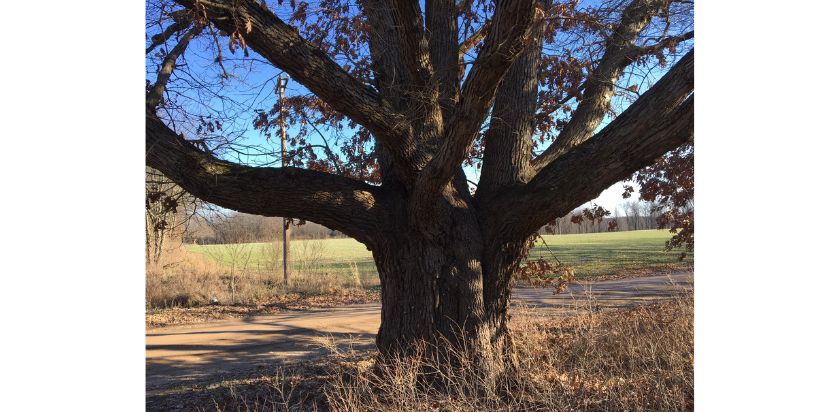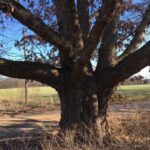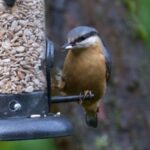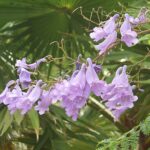Writer and outdoor enthusiast Sondra Willobee and her husband Ed have canoed, hiked, and camped throughout the United States. Sondra blogs about many of these adventures at Down by the Riverside. You may find you agree with me: she has a wonderful aptitude for connecting her astute observations about the nature all around us to human nature. She has graciously agreed to share her experience with a tree on one of her hikes with us.
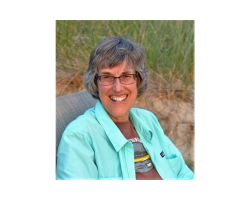
Touching the White Oak
How could I have missed it?
A huge white oak tree at the edge of the fence line alongside a hiking trail we frequent. Seventy feet tall, five feet in diameter, the oak’s stout, horizontal branches were themselves the size of small trees. This massive specimen had the wide-spreading branches and rounded crown of the classic eastern white oak. The fissured bark was as deeply folded and wrinkled as the skin of an elephant.
But I had walked by without seeing it.
April 12, 2020
I had plenty of reasons, however, to walk blindly with my head down. It was April 12, 2020.
Do you remember the first months of the COVID-19 pandemic?
People stockpiled food and hoarded toilet paper. The bread shelves in the grocery store were completely empty. You couldn’t even buy pumpernickel rye.
My husband, Ed, swabbed our groceries with disinfectant wipes before putting them in the pantry. Amazon packages sat for three days in my brother’s living room before he’d open them up.
Photos on Facebook showed nurses curled up on metal carts, sleeping in halls.
We hunkered down at home, searching the Internet late at night for descriptions of COVID-19 symptoms, screens flickering in the dark, worrying that any sniffle or cough meant we’d contracted the virus.
Maybe passed it to someone else.
Our niece, a nurse on a COVID-19 floor, described what was happening in hospitals: “I’ll never forget the nights we heard dozens of emergency intubation calls; gearing up to hold iPads in dying patients’ rooms and trying not to cry while their families prayed and sang and wept with them; learning the trade of hospice nursing on the fly because our patients were dying and we had no choice.”
Morgues in Italy had closed because there were too many bodies.
We were overwhelmed by bad news. How to cope? Like many other people, I was eating too much, drinking too much, and sleeping badly.
Lakelands Trail Treasures
The best thing that could be said was that I was taking a hike every day.
On this particular day, my husband, Ed, and I were walking the Lakelands Trail west of Pinckney. A thirty-two-mile linear state park on an abandoned Grand Trunk Railway bed, the crushed limestone trail heads due west in such a straight shot that it seems like you could walk forever.
I guess you could walk all the way to Lake Michigan if you wanted since the Lakelands Trail is part of the 275-mile Great Lake-to-Lake Trails that goes from Port Huron to South Haven.
We crossed a tributary of Honey Creek that feeds the wetland corridor on either side of the raised grade. Spying a bright yellow island of marsh marigolds, I teetered on the steep bank to take a picture. Cups of gold rose on succulent stalks from the decaying pieces of last year’s oak leaves.
I heard the call of wood frogs, a hoarse clucking like ducks with a sore throat.
Standing quietly, I could see a few striped brown frog heads just above the water, the dark eye patches like masks. In my days doing frog and toad surveys for The Friends of the Rouge River, I had learned that wood frogs are “explosive breeders.” Their breeding time of one or two weeks is the shortest of any Michigan frog or toad.
“They are not shy,” the Friends of the Rouge website says. “They will call day or night.” Good for you, little frogs, I thought. Good for you.
I climbed up the bank and picked up my pace.
News stories that expressed bravery and kindness and hope rose in my mind. I thought of public health officials who braved criticism to make difficult decisions. I thought of front-line workers who stayed in place without knowing if the person in front of them carried the virus. I thought of weary doctors and nurses protected only by re-used masks and scrounged PPE who continued to make their rounds.
“Thank you,” I said aloud.
The Discovery
After two miles, Ed and I turned around and headed back to where we’d started. When we neared the car, there, alongside the trail, was the huge white oak.
“Look at that,” I said to Ed.
He spread his arms to measure the trunk. “Could be a hundred, maybe two hundred years old,” he said.
How did this particular tree escape the sawyer’s blade and the barrel-maker’s stave? In colonial times, white oak wood was prized for shipbuilding and for the making of wine and whiskey barrels. Around us, too, were fields planted in winter wheat. I wondered how some farmer had not chopped it down.
I considered how many seasons, how many droughts, how many windstorms, this tree had seen. How many leaves had it let loose, how many egg-shaped acorns released?
I placed my palm against the trunk and felt the ridges of the deeply-furrowed bark. I took in a deep breath and let it go. If I could learn the perseverance of this oak, perhaps this time of trouble could be redeemed.
I will simply try to trust and practice good habits, I told myself.
Pray and keep walking.
For Now
I suspected that the habits would bear fruit only bit by bit, in the same way that Anne Lamott described her liberation from professional jealousy in Bird by Bird: Some Instructions on Writing and Life:
“I was waiting for the kind of solution where God reaches down and touches you with his magic wand and all of a
— Anne Lamott, Bird by Bird: Some Instructions on Writing and Life (New York: Pantheon Books, 1994), page 127
sudden I would be fixed, like a broken toaster oven,” Lamott wrote. “But this is not the way it happened. Instead, I got one angstrom unit better, day by day.”
Things will improve, I said to myself. One angstrom unit at a time.
For now, it was enough to touch the bark of the oak.
For now, it was enough just to hear the frogs.
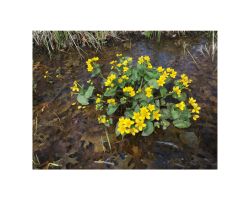
Note from Maureen: If you like nature and/or find yourself wondering about some of the bigger questions in life, check out Sondra’s blog Down by the Riverside: https://www.sondrawillobee.com/blog.
Sondra Willobee most recently served as lead pastor at South Lyon First United Methodist Church in southeast Michigan. She is an adjunct professor of preaching at Methodist Theological School in Delaware, Ohio. Her first full-length book, The Write Stuff: Crafting Sermons that Capture and Convince, brings together her love of preaching and her passion for writing. Her articles, reviews, poems, and stories have appeared in religious and literary journals including The Christian Century, Christianity Today, Driftwood Review, and Windhover.
The photo of the featured image of the white oak tree at the beginning of this blog posting is by Sondra Willobee.


